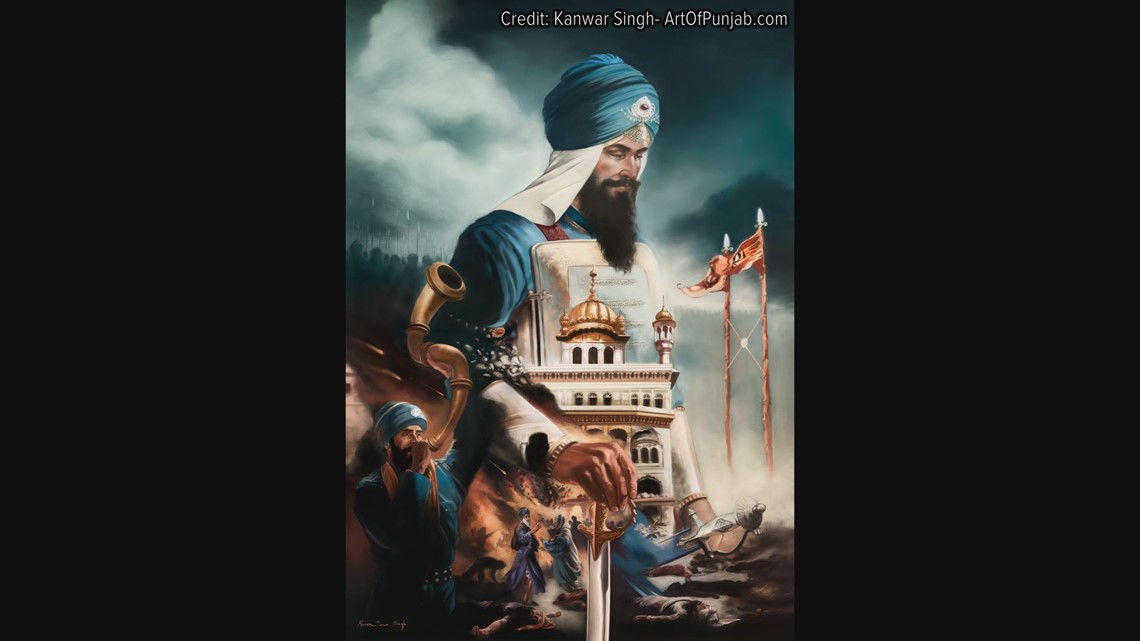Members of the world's fifth largest religion stand out in America. But ask who Sikhs are and what they believe and studies show up to 70 percent of Americans won't be able to answer.
“On one hand we're hyper visible with our unique identity, our turbans, our beards,” said Simran Jeet Singh with the Sikh Coalition, a non profit founded after the Sept. 11 tragedies.
“People definitely noticed me in an airport or on an airplane right? We're noticeable. And at the same time, people have no idea who we are.”
Today, there are approximately 30 million Sikhs worldwide. There are roughly 1 million Sikhs living in North America.
“Whenever I have to explain anyone who I am, what's my identity, I always tell them Sikhs used to be warriors,” said Deb Bhatia, founder of the non profit Sikhs of St. Louis.
One of the world’s youngest major religions


Originating in the 15th century in the Northern region of India known as Punjab, Sikhism was established during a time where superstition and social inequity ruled the land.
Sikhism's founder, Guru Nanak, was born into a Hindu family. From a young age, he sought to establish a faith that considered all people- regardless of caste or gender- equal.
They called themselves Sikhs, which means "students" in Sanskrit. The term "Guru" translates to "teacher." Over the course of 2.5 centuries, there were 10 Sikh Gurus. At the start of the 18th century, the Guruship was finally passed on by the 10th guru to the holy Sikh scripture, Guru Granth Sahib, which is now considered the living Guru by the followers of the Sikh faith.


“Sikhism is more about believing in humanity. Sikhism means that there is one God. We see a human race as one race,” said Bhatia.
The history (and meaning) behind the Sikh Turban
Early in its history, Sikhs had to defend their faith against the Mughal empire and tyrannical rulers who persecuted religious minority groups.
That's when Sikhism’s 10th Guru, Guru Gobind Singh Ji, officially made the turban a symbol of the faith.


"Only Sikhs basically wear turbans,” said Vik Singh Saluja from Chesterfield, Missouri.
Vik and his wife, Pav Kaur Saluja, are Sikhs living in Chesterfield, Missouri.
They explain, other middle eastern and Asian cultures often wear head coverings that may look similar, but a Sikh’s turban is unique. It served in part, as a way to identify Sikh warriors during battle.
“When [Sikhs] were in war and they could not even identify who were the Hindus or the Muslims that they were fighting against, Guru Gobind Singh Ji actually turned and said, ‘The way that you will be identified is through your turban. And if anyone sees a man with a turban, they'll know that that's the person that you need to go to for protection,’” said Pav.


“Nothing has changed after so many years. You see a Sikh standing in the crowd and you need help, you go tell them and say, 'hey, man, I need help. You have to help me',” said Bhatia.
Prior to the founding of Sikhism, turbans were worn by India’s upper-class and cultural elite. Kings and rulers once wore turbans. However, a core teaching of the Sikh faith is that all people are equal.
In order to eliminate the class system associated with turbans, Guru Gobind Singh Ji declared every Sikh- man or woman- keep their hair uncut, and wear a turban. Other Purposes of the turban include protecting Sikhs' long unshorn hair and keeping it clean.
“We don't cut the hair because God has told us that we should keep our bodies the same way as we were gifted by the God,” said Bhatia. Not every Sikh wears a turban. Some also choose to cut their hair for personal reasons.
Sikhism’s last Guru also rejected the caste system by giving all Sikhs the last names Singh (Lion) or Kaur (Princess). Today, you can find Sikhs use ‘Singh’ and ‘Kaur’ primarily as middle names.
Sikhism’s last Guru also introduced five symbols that have become the markers of Sikh identity. They’re called the five "K’s" and only the most intensely dedicated Sikhs keep these distinctive emblems of Sikh identity. They include: uncut hair (Kes), a short sword or knife (Kirpan), a steel wristband (Karha), a wooden comb (Kangha) and shorts worn as an undergarment (Kacchera). According to Harvard University’s Pluralism Project, "the Five K’s continually remind Sikhs of the ethical and spiritual implications of aligning one’s life with truth."


Sikhism’s last Guru also introduced five symbols that have become the markers of Sikh identity. They’re called the five K’s and only the most intensely dedicated Sikhs keep these distinctive emblems of Sikh identity. They include: uncut hair (Kes), a short sword or knife (Kirpan), a steel wristband (Karha), a wooden comb (Kangha) and shorts worn as an undergarment (Kacchera). According to Harvard University’s Pluralism Project, the Five K’s continually remind Sikhs of the ethical and spiritual implications of aligning one’s life with truth.




Sikhs in America
Singh or Kaur, Sikhs have been in America since the 1890's. So why do so few people know about Sikhs?


“In our religious tradition, we don't have a history of proselytizing. Because we're not going around announcing who we are and trying to convince other people to be like us. You know, there's no PR effort, at least not traditionally within the Sikh faith and so perhaps that has something to do with why folks don't know us as well,” said Simran Jeet Singh.
Unfortunately when we do see Sikhs in the media, it's often in the aftermath of violence. Recent examples include the mass shooting at a FedEx facility in Indiana that claimed the lives of eight people. Among them- four Sikh FedEx workers.
Targeted
FBI hate crime data shows Sikhs are the third most commonly targeted religious group in America -- behind Jews and Muslims.


“We experienced a significant uptick in hate, violence, after 9/11 and that uptick has not slowed down,” said Simran Jeet Singh.
“After 9/11, right, people saw the face of the person who was responsible for it was wearing a turban,” said Vik Saluja. “Sikhs basically got mid-identified or mis-targeted and they basically became collateral damage with the anti-Muslim or anti-Islam sentiment that came about.”
Different types of discrimination
The targets of racism in America are constantly shifting based on national and international events.
“When my father first arrived in the 70s, he was perceived as the threat because he looked like, at least according to American sensibilities, he looked like the Ayatollah,” said Simran Jeet Singh.
“When I was growing up in the 80s and 90s, the enemy shifted to Iraq, and I was called ‘Saddam.' And then 9/11 happens and the game again changed and the slurs that we received were ‘Bin Laden,' ‘Taliban’ and ‘Al Qaeda.' Racism is constantly shifting and adapting depending on who Americans perceived threat to be."
While Sikhs peacefully practice their religion, you also find them feeding the hungry and giving back to the communities they live in.
Through the tradition of Langar, the practice of preparing and serving a free meal to promote the Sikh tenet of selfless service, Sikhs serve an estimated 7 million meals a day worldwide.
The meals go to whoever needs them and have helped thousands facing food insecurity during the pandemic.
It’s a key component of the work Bhatia does with Sikhs of St. Louis, which has helped serve thousands of meals around the area.
“When we serve meals, we don't see caste, we don't see color, we don't see religion. It's for anyone and everyone. We all know actions speak louder than words. Sharing a food with someone connects you to them,” said Bhatia.
Recently, Sikhs in India have set up “oxygen Langars” for covid-19 patients struggling to find oxygen as COVID cases continue to rise in the country. Drive-through tents have also been set up outside Sikh places of worship- called Gurdwaras. No one is turned away.
Through these traditions, Sikhs continue to peacefully practice their religion around the world. At the heart of their religion is a responsibility to help others.
“There's something really profound in this in this simple teaching that divinity is equally present in every single one of us,” said Simran Jeet Singh. “Because if you truly recognize the goodness in everyone and in the world around you then, even in the most difficult moments, it becomes possible to find silver linings and to find hope.”

